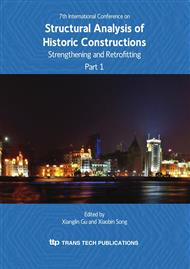p.275
p.283
p.289
p.295
p.301
p.307
p.313
p.319
p.325
Experimental and Numerical Analysis of a Two-Span Model Masonry Arch Bridge Subjected to Pier Scour
Abstract:
A scaled model of a two-span masonry arch bridge has been built in order to investigate the effect of the central pile settlement due to riverbank erosion. The bridge model has been equipped with different Non Destructive Testing (NDT) instruments and subjected to incremental settlement of the pier. The evolution of the pier scour has been investigated experimentally by means of a hydraulic model and reproduced accordingly. The numerical interpretation of damage, carried out by finite element analyses, has been compared with the results of the Acoustic Emissions (AE) monitoring. Several ultrasonic emissions have been detected and main damage source areas have been localized.
Info:
Periodical:
Pages:
301-306
Citation:
Online since:
October 2010
Price:
Сopyright:
© 2010 Trans Tech Publications Ltd. All Rights Reserved
Share:
Citation:


